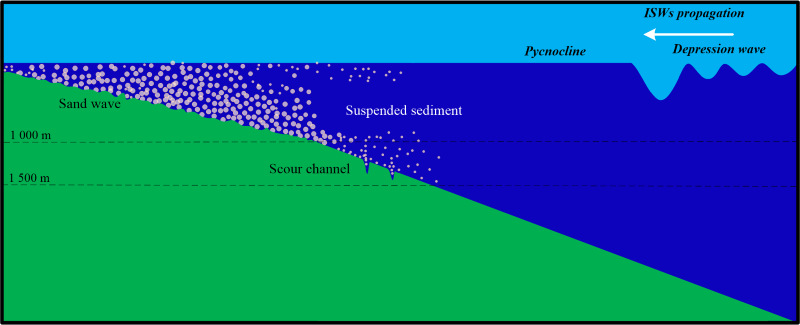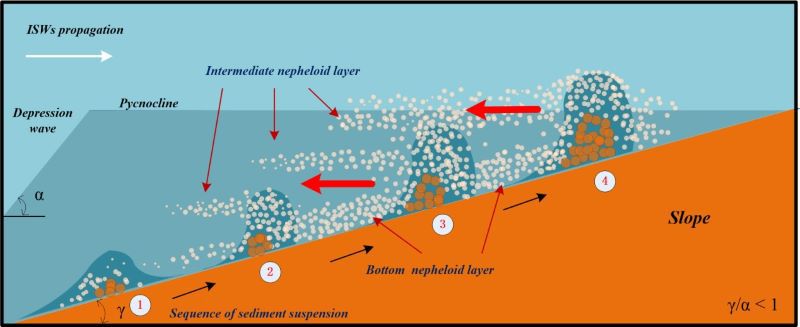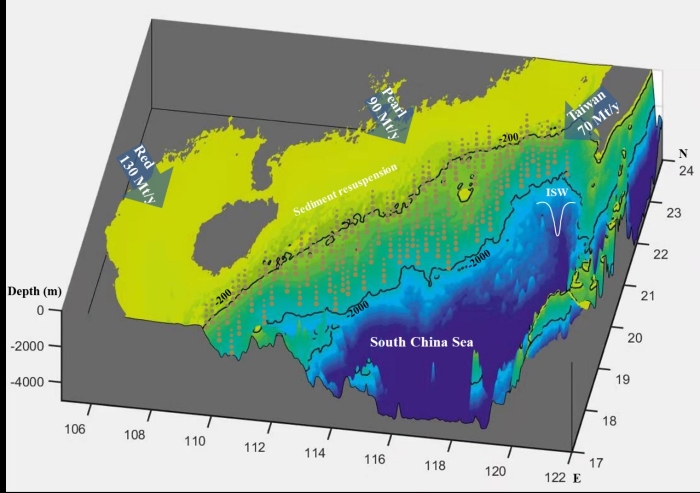5月17日,国际著名流体力学杂志《Physics of Fluids》发表了团队青年讲师田壮才关于南海内孤立波悬浮深海沉积物并改造海底底形的最新研究成果“Internal solitary waves induced deep-water nepheloid layers and seafloor geomorphic changes on the continental slope of the northern South China Sea”。最新研究发现内孤立波所造成海底沉积物悬浮在南海北部陆坡可达1500米水深,并成为《Physics of Fluids》的 Fearured and Scilighted 文章。

内孤立波可在浅水和深水环境中诱发海底沉积物的再悬浮,并形成海洋雾状层。然而,内孤立波在1000 m以深的海洋环境中对海底沉积物的悬浮和海底底形的作用仍不清楚。为了解答上述问题,在南海北部东沙海域进行覆盖300m-2000 m水深的整个大陆坡的悬浮颗粒浓度剖面测量以及海底多波束调查。研究发现在水深700 m以浅的上陆坡,海底沉积物受到内孤立波严重扰动并再悬浮,内孤立波可在水深1000 m以浅的海底改造海底底形,内孤立波造成海底沉积物再悬浮最深可达1500 m。东沙陆坡东侧海底表层沉积物的分布模式主要受控于内孤立波,内波反射理论可以应用于上陆坡,但下陆坡海底沉积物的悬浮与海底地形有关。
该研究进一步发现内孤立波对深海海底的巨大影响,为深入研究内孤立波在边缘海输运沉积物和深海沉积奠定基础。

浅化内孤立波在陆坡悬浮沉积物示意图
内孤立波在水深1000 m以浅剧烈悬浮海底沉积物,并改造海底底形,形成沙波等底形,悬浮沉积物的最大水深为~1500 m。
论文第一作者为团队青年讲师田壮才,通讯作者为团队负责人贾永刚教授以及张少同和田壮才。该研究是中国海洋大学、中国矿业大学、中国地质调查局青岛海洋地质研究所、美国North Carolina State University和自然资源部第一海洋研究所合作研究成果。本研究得到国家自然科学基金重大仪器专项(41427803)和国家自然科学基金重点项目(41831280)的联合资助。
内孤立波是一种特殊的非线性内波,广泛分布在全球海洋中,中国南海为世界最大振幅内孤立波发生的海域。内孤立波可引起海水与海底之间显著的相互作用,是浅水和深水环境中沉积物再悬浮的有效成因,并对生态和地质过程产生重要影响。
深海物质输运一直是海洋领域国际研究的前沿和热点,内孤立波的输运机制关系着深海沉积物的输运,对海底演化和地质灾害防控具有重要意义。
中国海洋大学贾永刚教授团队围绕内孤立波与海底相互作用长期开展研究,已经取得大量研究成果,揭示了内孤立波的沉积动力学过程,建立了浅化内孤立波形成底部和中部雾状层的机制,确定了内孤立波悬浮海底沉积物的最大水深和扰动海床深度的范围,并进一步对南海内孤立波悬浮海底沉积物量进行预估。相关系列研究成果发表在《JGR: Oceans》,《Physics of Fluids》,《Journal of Marine Systems》,《Appiled ocean research》,《Scientific Reports》,《Bulletin of Engineering Geology and the Environment》等国际重要学术期刊。

浅化内孤立波悬浮沉积物过程示意图

内孤立波在传播区形成底部雾状层和中部雾状层过程示意图

南海北部三维地形图以及主要河流的分布及其年沉积物输入量
Source:
1) Zhuangcai Tian*, Yonggang Jia*, Jiangxin Chen, J. Paul Liu, Shaotong Zhang*, Chunsheng Ji, Xiaolei Liu, Hongxian Shan, Xuefa Shi, and Jiwei Tian. Internal solitary waves induced deep-water nepheloid layers and seafloor geomorphic changes on the continental slope of the northern South China Sea [J]. Physics of Fluids, 2021, 33(5).
2) Zhuangcai Tian, Yonggang Jia*, Shaotong Zhang, Xiaojiang Zhang, Xiujun Guo. Bottom and Intermediate Nepheloid Layer Induced by Shoaling Internal Solitary Waves: Impacts of the Angle of the Wave Group Velocity Vector and Slope Gradients [J]. Journal of Geophysical Research: Oceans, 2019, 124(8): 5686-5699.
3) Zhuangcai Tian, Shaotong Zhang, Xiujun Guo*, Le Yu, Yonggang Jia*. Experimental investigation of sediment dynamics in response to breaking high-frequency internal solitary wave packets over a steep slope [J]. Journal of Marine Systems, 2019, 199: 103191.
4) Zhuangcai Tian, Xiujun Guo*, Luzheng Qiao, Yonggang Jia. Experimental investigation of slope sediment resuspension characteristics and influencing factors beneath the internal solitary wave-breaking process [J]. Bulletin of Engineering Geology & the Environment, 2019, 78(2): 959-967.
5) Zhuangcai Tian, Tian Chen, Xiujun Guo*, Le Yu, Yonggang Jia*. Penetration depth of the dynamic response of seabed induced by internal solitary waves [J]. Applied Ocean Research, 2019, 90: 101867.
6) Yonggang Jia, Zhuangcai Tian, Xuefa Shi, J. Paul Liu, Jiangxin Chen, Xiaolei Liu, Ruijie Ye, Ziyin Ren, Jiwei Tian*. Deep-sea Sediment Resuspension by Internal Solitary Waves in the Northern South China Sea[J]. Scientific Reports,2019,9(13).
Scilight: Large waves deep within oceans shape the seafloor of the article was published online today, 05-17-2021. You can read it at: https://doi.org/10.1063/10.0004959
